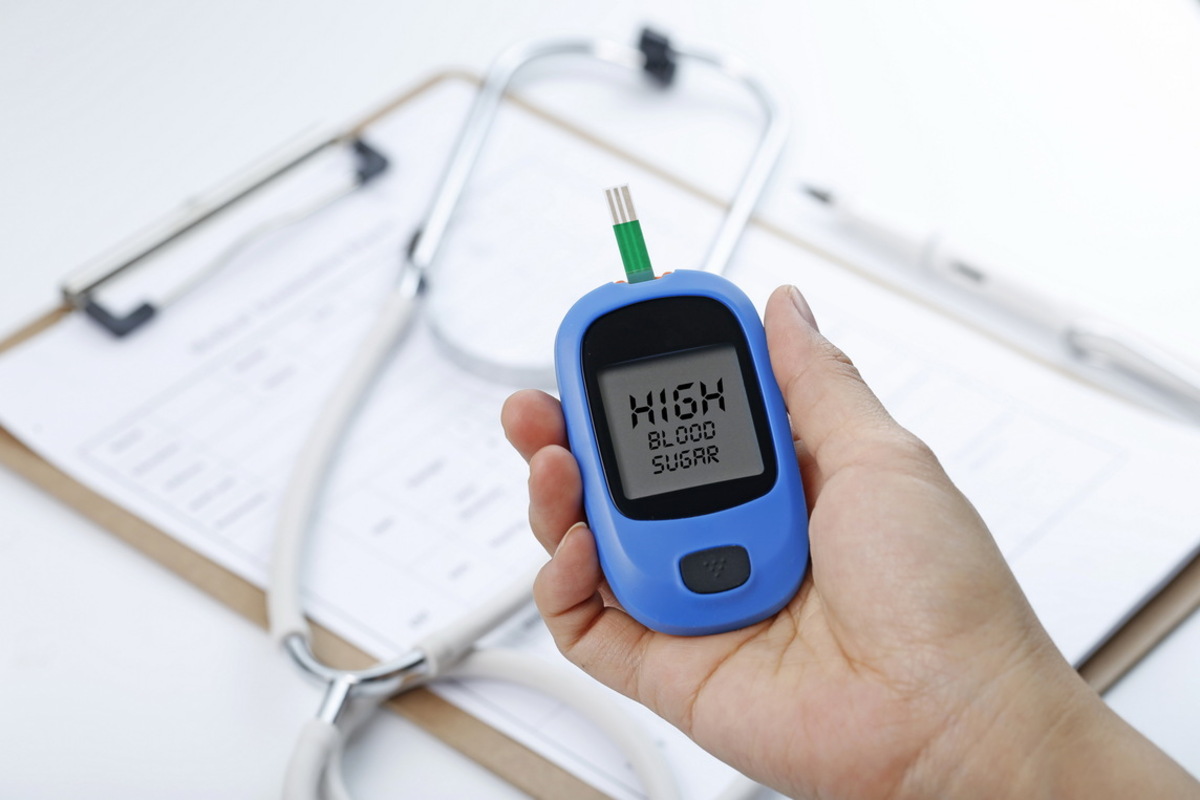Diabetes is characterized by high blood sugar levels, or "hyperglycemia". In fact, hyperglycemia is the main symptom of diabetes and its presence is what allows for a diagnosis of diabetes. Hyperglycemia is a very dangerous condition that can, if left untreated, lead to a significant number of complications. Therefore, people with hyperglycemia must always keep track of their blood sugar levels and try to stay within the target range.

So, how do people become hyperglycemic?
To understand how hyperglycemia develops, it is important to first learn how glucose (a type of sugar) is metabolized within the body. When people eat carbohydrates, the body breaks them down (metabolizes them) into a sugar known as glucose. When the body has high levels of glucose, as it does right after you eat a carbohydrate-heavy meal, the pancreas releases a hormone called insulin. This hormone plays an important role in allowing your body to absorb the sugars from your blood for energy. Hyperglycemia develops when this process no longer works for one reason or another.
There are two major types of diabetes — type 1 and type 2.
Patients with type 1 diabetes become hyperglycemic because autoimmunity, in which the immune system goes haywire and starts to attack the body’s own tissues. In the case of type 1 diabetes, the pancreas becomes a target. Hence, the cells responsible for producing insulin are no longer able to do so. A lack of insulin means that glucose can't be absorbed by the cells for energy and therefore remains in the blood, leading to high blood sugar levels which are very detrimental to the body.
The second type of diabetes is type 2 diabetes. Unlike type 1 diabetes, the immune system works fine in people with type 2 diabetes. However, cells become resistant to the actions of insulin. Despite the fact that insulin is being produced and trying to do its job, the cells no longer respond. This leads to hyperglycemia.
People can develop hyperglycemia for several reasons besides diabetes — and these factors can also occur in diabetics, making their condition even worse:
- Consuming too many carbohydrate-rich foods.
- Not exercising, as exercising helps glucose metabolism.
- Not taking in enough insulin (if diabetic) or not being adherent to other medications.
- Stress from illness or other situations can worsen hyperglycemia. In this case, many diabetes patients need to take extra medication to keep blood sugar levels stable.
- Other medications, such as steroids, can worsen hyperglycemia.
- The dawn phenomenon in which patients experience an increase in blood sugar levels between the hours of 4 and 5 am explains why many people have high blood sugar in the mornings.
Definition and diagnosis of hyperglycemia
Depending on the type of test that conducted to diagnose diabetes, the blood glucose levels vary in terms what is defined as being hyperglycemic or diabetic. They are as follows:
- For patients who undergo a fasting glucose test (in which patients have to fast for eight hours and then get tested), blood glucose levels of 100 milligrams per deciliter (mg/dl) point to prediabetes (a condition in which patients have elevated blood sugar levels that are not high enough to indicate diabetes) and blood sugar levels of 126 mg/dl or more denote diabetes.
- For patients who undergo an oral glucose tolerance test (in which patients are given a sugar-filled drink before blood glucose levels are monitored), blood glucose levels between 140 and 200 mg/dl indicate they are prediabetic, while blood sugar levels of 200 mg/dl or higher are a hallmark of diabetes.
- If the score on the A1C test, which is able to determine blood sugar levels over the past two to three months, is higher than 6.5 percent, that suggests a diagnosis of diabetes.
Symptoms of hyperglycemia
There are several symptoms of hyperglycemia, including:
- Blurry vision
- Frequent urination
- Excessive thirst
- Excessive hunger
- Unexplained weight loss
- Fatigue or tiredness
- Wounds and sores that don’t heal
- Numbness or tingling
- Dizziness
Complications associated with hyperglycemia
If blood sugar levels continue to stay high in the long-term, several complications can develop down the road. These include:
- Diabetic ketoacidosis. This is a severe complication of long-term high blood sugar levels in which the body starts to produce high levels of a toxic molecule called ketones (which are byproducts of fat breakdown).
- Hyperglycemic hyperosmolar syndrome. This syndrome can be fatal and lead to severe dehydration and even coma.
- Heart disease or stroke can occur because high blood sugar levels lead to blood vessel and nerve damage.
- Kidney disease.
- Eye disease, such as glaucoma and cataracts.
- Foot problems.
- Skin problems.
- Oral problems.
Hyperglycemia: Prevention and treatment
Hyperglycemia is preventable through a number of different methods, including:
- Staying active and exercising
- Having a healthy diet that is low in carbohydrates and sugars
- Having a healthy weight
- Managing stress properly
If hyperglycemia progresses to diabetes, treatments include insulin and other drugs that can help lower blood sugar levels.
- Umpierrez, Guillermo E., et al. "Hyperglycemia: an independent marker of in-hospital mortality in patients with undiagnosed diabetes." The Journal of Clinical Endocrinology & Metabolism 87.3 (2002): 978-982.
- Inzucchi, Silvio E., et al. "Management of hyperglycemia in type 2 diabetes: a patient-centered approach: position statement of the American Diabetes Association (ADA) and the European Association for the Study of Diabetes (EASD)." Diabetes Spectrum 25.3 (2012): 154-171.
- Ceriello, Antonio. "Postprandial hyperglycemia and diabetes complications: is it time to treat?." Diabetes 54.1 (2005): 1-7
- Photo courtesy of SteadyHealth


Your thoughts on this